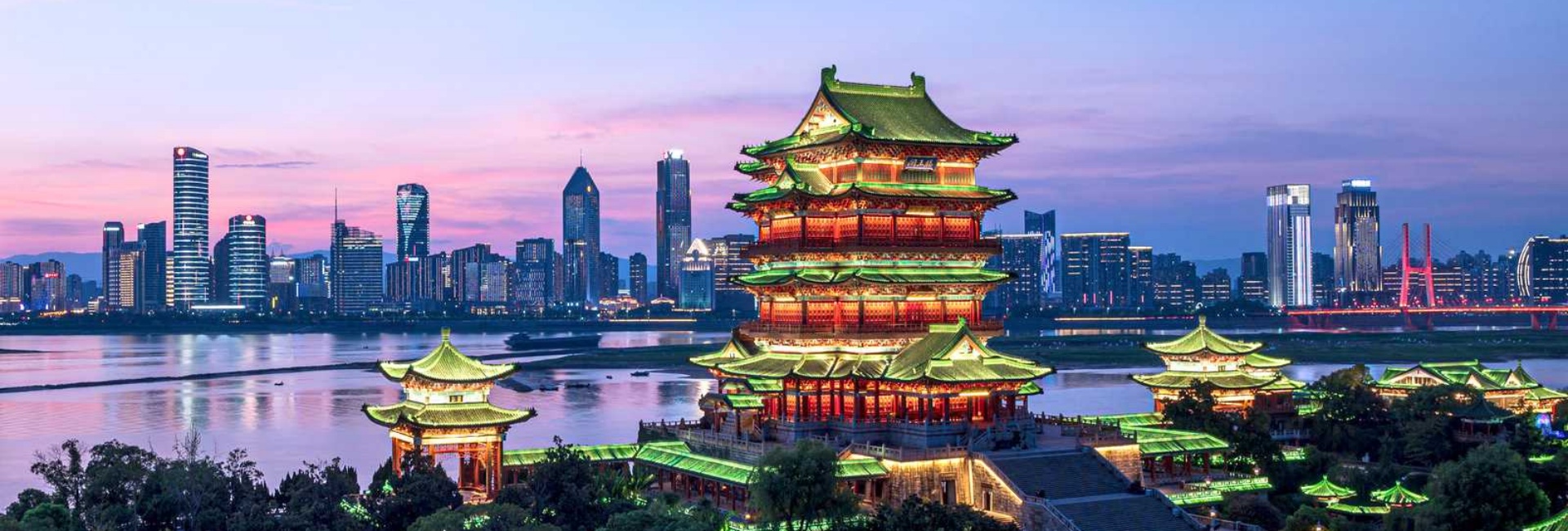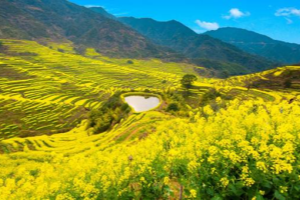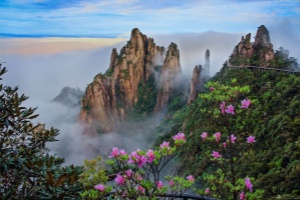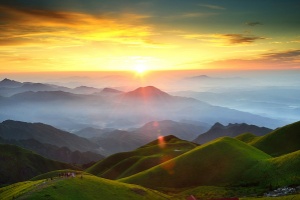Jiangxi Travel Guide
Jiangxi, this land full of mystery and charm, is like a silent poet who tells the stories of thousands of years through its landscapes, culture, and history.
Jiangxi boasts magnificent mountains and rivers, which seem like freely painted scrolls by nature. Mount Lu Scenic Area, with its mist-shrouded peaks, appears ethereal and enchanting, leaving visitors captivated and reluctant to leave. Poyang Lake, with its sparkling surface, resembles a mirror reflecting the ever-changing sky. Wandering through these natural landscapes, one feels immersed in beautiful paintings, forgetting all the worries of the mundane world.
Jiangxi also boasts a profound cultural heritage. It has nurtured numerous cultural luminaries, and their poems, songs, calligraphy, and paintings are all treasures of Chinese culture. Stepping into Tengwang Pavilion, it seems one can hear the chanting voice of Wang Bo and feel the grandeur of "the setting sun and the solitary wild goose flying side by side, the autumn waters merging with the vast sky in a single hue." Walking through the porcelain street of Jingdezhen, one is amazed by the exquisite porcelain pieces that sparkle like artwork.
Moreover, the history of Jiangxi is also filled with legendary tales. The footprints of the Red Army's Long March are scattered across this land, and their heroic deeds have inspired generations of people. Stepping into Jinggangshan, one can hear the resounding horn blasts and feel the bravery and courage of the revolutionary martyrs.
Jiangxi, this land full of charm, awaits your exploration and discovery. It not only boasts beautiful natural landscapes but also a profound cultural heritage and legendary history. Whether you are fond of natural scenery or passionate about historical culture, you can find your share of touch and surprise in Jiangxi.
Let’s embark on a journey to Jiangxi, feeling the beauty and charm of this land with our hearts. Let the trip become a baptism of our soul, a dialogue with history, and a collision with culture. In the embrace of Jiangxi, we are bound to gain a wealth of touch and memories, leaving unforgettable footprints.
Features
Chinese: 江西 Jiangxi Area: 166,900 square meters
Time Zone: UTC+ 8 Population: about 45,180,000
Location: Southeast of China Climate:Subtropical monsoon humid climate
Post Code:330000-344000 Administration: Non-autonomous region
Area Code: (+86) 0790-0799 Annual rainfall: 1567.7 mm
Top Jiangxi Attractions | Best Places to Visit in Jiangxi 2024/2025
Jiangxi Province, abbreviated as “Gan”, is a charming province located in the southeastern part of China, on the south bank of the middle and lower reaches of the Yangtze River. It borders Zhejiang and Fujian to the east, Guangdong to the south, Hunan to the west, and Hubei and Anhui to the north. Located in the central hinterland of the Yangtze River Delta, the Pearl River Delta, and the west bank of the Taiwan Strait, Jiangxi has a strategically significant geographical position.
Jiangxi boasts a long history and profound cultural heritage. As early as tens of thousands of years ago, human activities had already taken place in Jiangxi during the Paleolithic Age. Since the establishment of Yuzhang Prefecture in the early years of Emperor Gaozu of the Han Dynasty, the administrative system of Jiangxi has undergone several changes, but it has always been an important region in China. This land has brought up a rich red culture, landscape culture, ceramic culture, academy culture, opera culture, agricultural culture, commercial culture, and traditional Chinese medicine culture. Each culture represents the unique charm of Jiangxi.
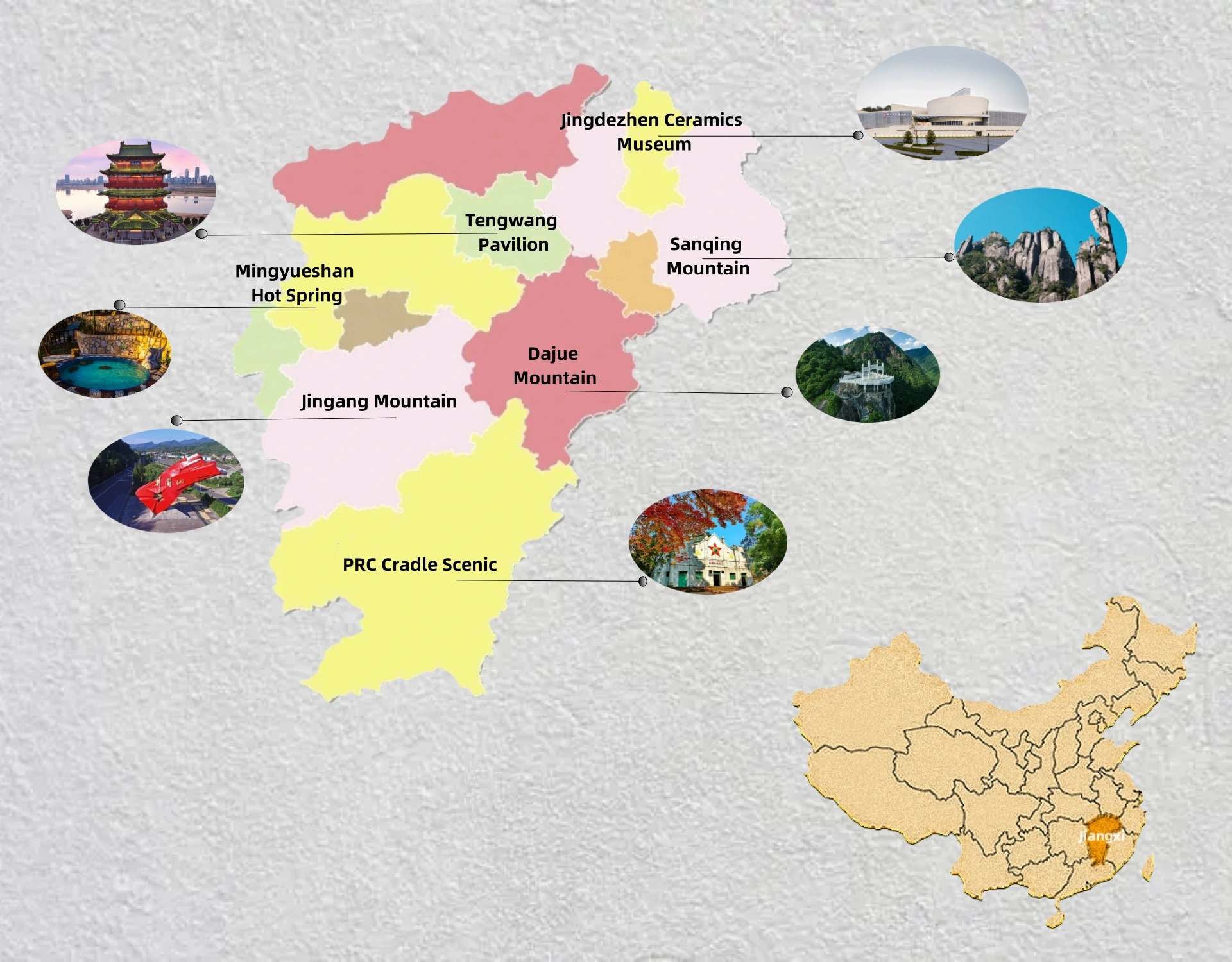
Jiangxi boasts magnificent natural scenery. Here stands Mount Lu, renowned as “the most exquisite and wonderful scenery under the heavens”, with its clouds and mist hovering like a fairyland; there is Panyang Lake, the largest freshwater lake in China, with its vast and lively expanse of waves; and numerous scenic spots such as Mount Sanqing, Jinggangshan, and Longhushan, each filled with the magical charm of nature.
Top Attractions in Jiangxi
 The Tengwang Pavilion
The Tengwang Pavilion
The history of the Tengwang Pavilion dates back to the fourth year of Yonghui in the Tang Dynasty (653). It was built by Li Yuanying, the younger brother of Emperor Taizong Li Shimin when he was serving as the governor of Jiangnan Hongzhou. After several repairs and reconstructions, the current Tengwang Pavilion was rebuilt in 1985, showing its brand-new look. In 2018, the Tengwang Pavilion Tourist Area was officially approved as a national AAAAA-level tourist attraction by the National Tourism Scenic Spot Quality Rating Committee, becoming a popular tourist destination for both domestic and international tourists. The Tengwang Pavilion also holds significant value in tourism. In Wang Bo’s Tengwang Pavilion Preface, a poem from the early Tang Dynasty, the description of “the setting sun and the lonely wild goose flying together, the autumn waters sharing the same hue as the vast sky” not only showcases the magnificent scenery of the Tengwang Pavilion but also integrates people and objects, emotions and scenery, creating a uniquely aesthetic atmosphere. In 2004, the Tengwang Pavilion Tourist Area in Nanchang City, Jiangxi Province, including the Tengwang Pavilion, was approved by the State Council and listed as the fifth batch of national key scenic spots.
 The Jingdezhen
The Jingdezhen
Jingdezhen has been renowned for its porcelain since ancient times, earning the reputation of “the City of Porcelain”. As one of the birthplaces of global ceramic culture, Jingdezhen boasts a long history, exquisite skills, and far-reaching influence in ceramic culture. The history of ceramic production in Jingdezhen dates back to the Han Dynasty, but it was during the Song Dynasty that the city gained global fame due to the booming development of the ceramic industry. Here, ceramics are not only a daily necessity and artwork, but also a symbol of culture and spiritual sustenance. The ceramic culture of Jingdezhen integrates various ideological elements such as Confucianism, Buddhism, and Taoism, reflecting the essence and characteristics of traditional Chinese culture. Besides ceramic culture, Jingdezhen also boasts rich natural and cultural landscapes. The scenic beauty of its mountains and rivers is breathtaking, earning it the reputation of “the Heroic Town of Jiangnan”. At the same time, Jingdezhen has preserved historical relics such as ancient kiln sites and ancient dwellings, witnessing the glorious history and unique culture of this city.
 The Mount Lu
The Mount Lu
Mount Lu extends approximately 25 kilometers in length and 10 kilometers in width, with an oval-shaped mountain body and its main peak, Hanyang Peak, reaching an altitude of 1,474 meters. Mount Lu is renowned as the "Holy Mountain of Humanities" due to its unique geomorphology, beautiful scenery, and profound cultural heritage. It is known as "the most beautiful and unique place in the world under Heaven." The historical and cultural significance of Mount Lu is also extremely rich. It is said that during the Yin and Zhou dynasties, seven brothers of the Kuang family settled here and later ascended to immortality, and their huts transformed into mountains, hence the name of Mount Lu. Since Sima Qian recorded Mount Lu in the "Records of the Grand Historian," poets and scholars from various dynasties have come to admire it, leaving behind many precious masterpieces. Cultural celebrities such as Su Shi, Li Bai, and Bai Juyi have all left their footprints and poems here. After billions of years of natural evolution, Mount Lu has formed numerous rapids and waterfalls, the most famous of which is the Sanjiedian Waterfall, with a drop of 155 meters.
 The Jinggangshan
The Jinggangshan
In modern and contemporary history, Jinggang Mountain stands as the cradle of the Chinese revolution. In 1927, Mao Zedong led the Autumn Harvest Uprising(秋收起义) troops to establish the first rural revolutionary base in Jinggang Mountain, thereby charting a new path for the Chinese revolution. Over 100 well-preserved revolutionary sites and relics can be found here, with 26 designated as national cultural relics protection units, 6 as provincial-level units, and 35 as municipal-level civilized protection units. These sites bear witness to the arduous years of struggle and embody the revolutionary spirit of the Chinese people. Remarkably, Jinggang Mountain also serves as a natural sanctuary for various rare and endangered species, relics, and living fossils, providing a rare example of the Tertiary Fossian Forest Museum in the folded geological structure mountains of East Asia and South China.
 The Xiannv (Fairy) Lake
The Xiannv (Fairy) Lake
Xiannv Lake is a famous scenic spot that integrates natural scenery, cultural landscapes, and profound historical and cultural heritage. It is known as the largest subtropical tree species gene bank in Asia and one of the earliest lake-type scenic spots developed in Jiangxi Province. Xiannv Lake boasts a vast water area of 50 square kilometers, with over 100 islands scattered throughout the lake. The natural scenery here is beautiful and unsophisticated, combining the characteristics of both lake and mountain types. Visitors can appreciate the enchanting Wulong Lake, which is filled with winding streams and interconnected creeks, as well as the Zhongshan Gorge, where the water rushes swiftly between two towering peaks. The lake area also features natural landscapes such as Dagang Mountain and Yangtiangang National Forest Park, with a forest coverage rate of over 97%, providing visitors with a natural oxygen bar.
 The China Ceramics Museum
The China Ceramics Museum
The China Ceramics Museum, also known as the Jingdezhen Ceramics Museum, is the only professional museum dedicated to ceramic art in China that was established earliest and has rich collections of porcelain after the founding of New China. It was proposed by Mr. Guo Moruo and funded by the Development Bureau of the Ministry of Culture of the People's Republic of China in 1953 and officially opened to the public in 1954. The museum covers an area of nearly 59,000 square meters with a total construction area of 32,000 square meters. It collects over 50,000 ceramic masterpieces from various periods since the Neolithic Age, including pottery and porcelain from the Han and Tang dynasties. Among them, there are 18 sets of first-grade works, 236 sets of second-grade works, and 1,387 sets of third-grade works. There are 1,641 precious national cultural relics, covering representative varieties from various periods of Jingdezhen ceramic history. These precious collections showcase the profound heritage and exquisite craftsmanship of Chinese ceramic culture.
 The Poyang Lake
The Poyang Lake
Poyang Lake is the largest freshwater lake in China and the second largest lake in China after Qinghai Lake. It is located in the north of Jiangxi Province, across the three cities of Jiujiang, Nanchang, and Shangrao. It is one of the main tributaries of the middle and lower reaches of the Yangtze River, playing a significant role in regulating the water level of the Yangtze River, conserving water, improving the local climate, and maintaining the ecological balance of the surrounding area. Poyang Lake is rich in natural resources and biodiversity. It is home to many aquatic organisms, including fish, shellfish, aquatic plants, and more. At the same time, it is also an important channel and habitat for migratory birds, attracting tens of thousands of migratory birds to breed and roost every year. In the long river of history, the shape and area of Poyang Lake have undergone many changes, but it has always maintained its unique natural style and ecological value.
 The Sanqing Mountain
The Sanqing Mountain
Sanqing Mountain is a renowned Taoist mountain with a history of over 1,600 years. It is also a World Natural Heritage site, a World Geopark, and a national AAAAA-level tourist attraction. This mountain demonstrates a perfect combination of nature and humanity. Although the horizontal distance from the foot of the mountain to the top is only 5 kilometers, the altitude soars from 200 meters to 1,816 meters, and this terrain change brings unique natural landscapes to Sanqing Mountain. The biodiversity of Sanqing Mountain is also rich. There are 2,373 species of higher plants and 1,728 species of wild animals, which constitute the together environment of biodiversity in East Asia. These creatures thrive in every corner of Sanqing Mountain, adding endless vitality to this mountain range. Whether you are a mountain climber, a nature observer, or a cultural explorer, you can find your fun and gains here.
Red Well
 The Red Well
The Red Well
Ruijin City is the birthplace of the Provisional Central Government of the Chinese Soviet Republic and the location of the first nationwide red political power under the leadership of the Communist Party of China, hence it is known as the “Red Well.” During the War of Resistance Against Japan, it served as the cultural hub of the Central Soviet Area and was the political, military, economic, and cultural center of the entire Soviet Area. On November 7, 1931, the First National Congress of the Chinese Soviet Republic was convened in Ruijin, declaring the establishment of the first nationwide red political power under the leadership of the Communist Party of China - the Provisional Central Government of the Chinese Soviet Republic. As a result, Ruijin became known as the “red capital.” Ruijin City, the cradle of the Republic, is a significant landmark in the history of the Chinese Revolution. It witnessed the glorious journey of the Communist Party of China leading the people in arduous struggles and carrying the aspirations and pursuits of the Chinese people for a better future.
 The Wuyuan Scenic Area
The Wuyuan Scenic Area
The Wuyuan Scenic Area resembles a picturesque painting, blending the beauty of nature with human charm. Here, the mountains are covered with lush greenery, streams murmur, and ancient villages are dotted everywhere. Every scenery seems to be an artwork carefully crafted by nature. Named after the county town, Wuyuan Scenic Area is a national AAA-level scenic spot with rich rural charm and fresh, pleasant air. The natural landscapes here are breathtaking, with picturesque high mountain flower seas and charming scenes of small bridges, flowing water, and households. Jiangling Scenic Area is a highlight of Wuyuan, known as one of the four major flower seas in China. When spring comes and flowers bloom, standing in the vast terraced fields, the golden rape flowers contrast beautifully with the distant mountains, nearby waters, pink walls, and black tiles, forming a harmonious picture of man and nature. Here, you can let your soul roam freely and let all fatigue disappear amidst the beautiful scenery.
 The Mingyue Mountain
The Mingyue Mountain
The entire mountain range of Mingyue Mountain assumes a semicircular shape, resembling a half-moon, hence its name. The mountain range runs from northeast to southwest, with a total length of about 232 kilometers. The main peak, Taiping Mountain, rises to an elevation of 1,735.6 meters, making it the second-highest peak within Yichun City. Mingyueshan has a subtropical humid monsoon climate with an annual average temperature ranging from 12℃ to 15℃. The region receives adequate rainfall and abundant vegetation, making it an ideal escape from summer's heat. The landscape here is unique, with mild climate conditions conducive to the growth of various plants and animals. It is known as a “natural zoo” and a “kingdom of plants.” The Mingyueshan Tourism Zone also organically integrates moon culture with Zen culture and agricultural culture, creating a scenic cultural atmosphere where humans and the moon coexist in harmony, providing visitors with a rich cultural experience.
Main Scenic Area of West Sea of Mount Lu
 The Main Scenic Area of West Sea of Mount Lu
The Main Scenic Area of West Sea of Mount Lu
Main Scenic Area of West Sea of Mount Lu, formerly known as Yunju Mountain-Zhelin Lake Scenic Area, is composed of the large-scale reservoir, Zhelin Lake, and the Buddhist Zen sacred place, Yunju Mountain. Zhelin Lake boasts vast blue waves, surrounded by verdant islands, and its water quality meets first-grade atmospheric and first-class water quality standards. It is a rare type of landscape resource that combines magnificent mountain scenery with large-scale lake and island scenery. Yunju Mountain, on the other hand, is a renowned mountain with profound Buddhist cultural connotations, which has been a place for eminent monks and scholars to cultivate and lecture since ancient times. The landscape here, with its interplay between mountains and waters and a wealth of cultural heritage, forms a beautiful painting. Since ancient times, this place has been a gathering spot for literati, ink painters, eminent monks, and recluses. During the Eastern Jin Dynasty, Lushan Mountain became an important center for the dissemination of Buddhism. In the Sui and Tang dynasties, Lushan Mountain also emerged as a sacred place for Taoism, attracting numerous Taoist priests to come and cultivate. After the Song Dynasty, Lushan Mountain further became one of the birthplaces of Neo-Confucianism. Zhu Xi founded the Bailudong Academy here to teach Neo-Confucianist thoughts.
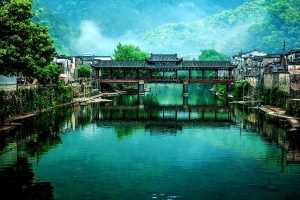 The Yaoli Ancient Town
The Yaoli Ancient Town
Located in a strategic position with beautiful natural scenery and profound cultural heritage, Yaoli Ancient Town is a dazzling pearl in Jiangxi Province. The ancient buildings within Yaoli Ancient Town are typical Jiangxi-style buildings, which are simple, elegant, and unique. It is known as the "Origin of Porcelain, Hometown of Tea, and Sea of Forests". Yaoli, formerly known as "Yaoli Kiln," got its name because it is the birthplace of Jingdezhen porcelain. As early as the mid-Tang Dynasty, manual workshops in this area produced porcelain, making it one of the three ancient kiln areas in Jingdezhen. The ancient mine pits, ancient kiln sites, water mills, and ancient workshops within the ancient town testify to the glorious history of the porcelain industry in Yaoli. Yaoli is also the birthplace of kaolin, a unique soil resource that creates special conditions for the porcelain industry.
......
Visit Jiangxi with Reliable Travel Agency
Thanks to its large size, Jiangxi is not flooded by visitors even in the peak seasons compared to other travel destinations. You will not need to join a queue for entering the spots.
To better explore Jiangxi, choose a reliable travel agency will help you make your dream tour come ture.
We are here to provide you unforgettable tours! We have been devoted to the inbound tourism for more than 20 years, with 98% 5-star review on TripAdvisor.
We will provide you the best service and price to guarantee you a great Jiangxi holiday.
Waiting for you in our Jiangxi ! :)





















